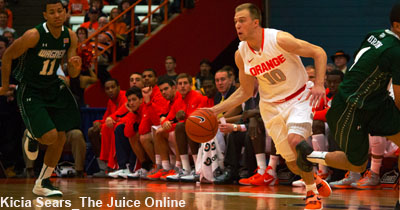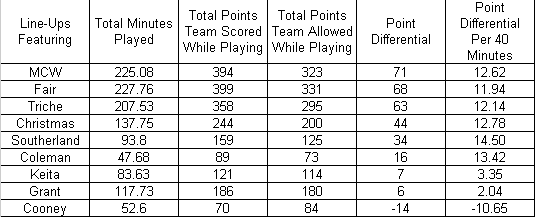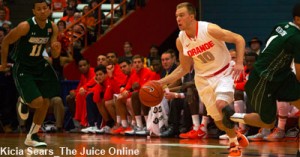
During the Providence game, I got an email from a buddy, Aaron Plante, that read, “I don’t understand why Jimmy doesn’t put in 1 of the knuckleheads with the other 4 seasoned players. Instead, with 10 minutes left in the half, he puts in 3 at once. And then Syracuse can’t score.”
It was a reaction to something that seemed obvious to both of us: Syracuse needed to give their starters a rest and give the bench guys some playing time to develop them, but by playing our three least productive offensive players all at the same time, we couldn’t run a decent half-court set. And yet, this rotation wasn’t an anomaly. It was something Boeheim had done with regularity and it got me thinking about which players and which lineups were the most and least productive.
So I did what any fanatical stat geek would do; I painstakingly charted the plus/minuses of every lineup Syracuse has used over their first six Big East regular season games. The original idea was to make a case for why Jerami Grant deserved more playing time (alongside the more experienced guys), but with James Southerland’s indefinite suspension, that argument ceased to be relevant. Still, the numbers I uncovered showed some very interesting and surprising things…

The table above isolates individuals to show what their plus/minus breakdown has been over the course of the first six Big East games. Below, I use some of the data that I’ve collected, to draw a few conclusions about the contributions (or lack thereof) of various individuals to the team. Tomorrow, in the second part of this article, I use additional data to discuss our best, worst, and most underutilized lineups.
» Related: Read Part II of the analysis
The Trevor Cooney Problem:
Over the past six games, Syracuse has outscored their opponents 404 to 347, for a point differential of +57. During those six games, when Trevor Cooney is on the bench, our point differential rises to +71, which means that when he’s actually on the court, Syracuse’s point differential is -14. Let that sink in for a moment. Cooney is the only (non walk-on) player to post a negative plus/minus over the past six games. To give you a little comparison, lineups that contain Michael Carter-Williams are +71 and lineups that contain Triche are +63. When Triche and MCW play together, without Cooney, SU is +74. Put a different way, lineups that contain Cooney are scoring 52.23 points per 40 minutes (PP40) and allowing 63.88 PP40. Lineups that don’t contain Cooney are scoring 71.29 PP40 and allowing 56.14 PP40. You don’t have to be a stat geek to know that’s bad, really really bad.

Now I think anyone who has watched Cooney in action, knows that he’s been struggling, but the stats are pretty damning, demonstrating just how much of a liability he has been on both sides of the ball. On offense, Cooney seems to confuse the idea of having the green light to shoot the ball whenever, wherever, with the idea that he should shoot the ball whenever, wherever. That mindset, coupled with (or perhaps contributing to) his woeful 29.6% from behind the arc on the season, means Syracuse has a lot of empty possessions when he plays. On defense, I applaud Cooney’s effort and energy level. He’s certainly disruptive, but he struggles with his spacing and he’s been totally unable to recover once an opposing player sets a ball screen. I don’t have the numbers, but Plante also pointed out to me that when Cooney is in the game, our defensive rebounding takes a huge hit, because he’s out of position and doesn’t have the reach or athleticism that Triche and MCW do, in order to pull in loose balls.
So what do we do about Trevor Cooney? Triche and MCW can’t play every available minute, nor should they. Cooney has to play, both to give our backcourt the occasional breather, and so he’ll develop as a player. With Southerland out indefinitely, we need outside shooting in a bad way and Cooney has the potential to be that guy (as his shooting problems largely seem to stem from issues with confidence and shot selection, rather than form). So when it comes to his minutes, the question becomes, do we sacrifice in the immediate so that he’ll have the experience he needs to develop in the long-run or do we keep his minutes low and pray that Triche and MCW avoid injury and/or foul trouble? I don’t know, but I’m sure it’s a question Boeheim wrestles with on a daily basis.
» Related: Donna Ditota on the SNY.tv Syracuse podcast
The Absence of James Southerland:
Syracuse has a +34 point differential when James is on the court, but is still +23 when he’s not in the game. Many people have noted that James was struggling with his three-point shot of late and that Jerami Grant has done a remarkable job of filling in for him since his suspension, so much so that we haven’t really needed him. The numbers suggest otherwise. Southerland’s +34 is for only three of the six Big East games (albeit against lesser competition), but the stat that speaks to his importance is Syracuse’s plus/minus in those three games: +34 when Southerland was on the court and only +8 while he was on the bench.
Syracuse is a far less efficient team when he’s unavailable. Villanova packed 5 guys behind the arc and dared us to shoot. Louisville and Cincinnati zoned us. And as long as Syracuse struggles to knock down outside shots, opposing teams are going to try force us into taking them. Southerland, even when he was off, required the attention of opposing defenses on the perimeter, which softened up their interior defenses and allowed Triche and MCW to penetrate and get the team higher percentage shots. We’re also missing him on the glass and especially on defense, where lineups featuring Southerland allowed a stingy 53.3 PP40.
And while Grant has played inspired basketball in Southerland’s absence, he’s not an outside threat like Southerland, nor is he as good of a team defender or defensive rebounder, and not coincidentally, lineups featuring Grant are far less efficient than ones featuring Southerland. Grant’s plus/minus is +6 over the past six games. The low point differential is understandable since the bulk of his minutes have come against the likes of Villanova, Louisville, and Cincinnati. Plus, his point differential rises to +21 when he’s on the court without Trevor Cooney. Still, suggesting that the loss of Southerland hasn’t and/or won’t hurt this team, is sorely mistaken.
» Related: Are you concerned about SU’s centers?
The Three Bigs:
During the Cincinnati presser, Boeheim said that Keita was our best defensive center, but the worst on offense, Coleman was just the opposite, our best offensive big, but the worst on defense, and Christmas was probably our best overall option since he’s pretty good on both sides of the ball… but only when he’s active. The numbers seem to back this up. Syracuse is +7 when Keita is on the court, +16 when Coleman is on the court, and +44 when Christmas is on the court. Now it should be noted that Coleman’s and Christmas’ point differential is inflated and Keita’s is lower than expected, because the former two played sparingly against Louisville and Cincinnati, while the latter saw the bulk of the playing time against our two toughest foes.
Interestingly, the numbers suggest that Coleman deserves a bit more playing time. He has only played 47 minutes and 41 seconds over the past 6 games, but in that time, his lineups are posting 74.66 PP40 and only allowing 61.24 PP40. That’s nearly 7.5 PP40 higher than the team’s average of 67.33 PP40, while only marginally worse than the 57.83 PP40 the team allows. Now, as mentioned above, he’s played fewer minutes against worse opponents, but when he’s surrounded by four other solid players, he’s actually been part of Syracuse’s most efficient lineup. Which lineup is that? Check Part II for the answer.
For more Syracuse coverage, Like our Facebook page and follow us @TheJuiceOnline.
